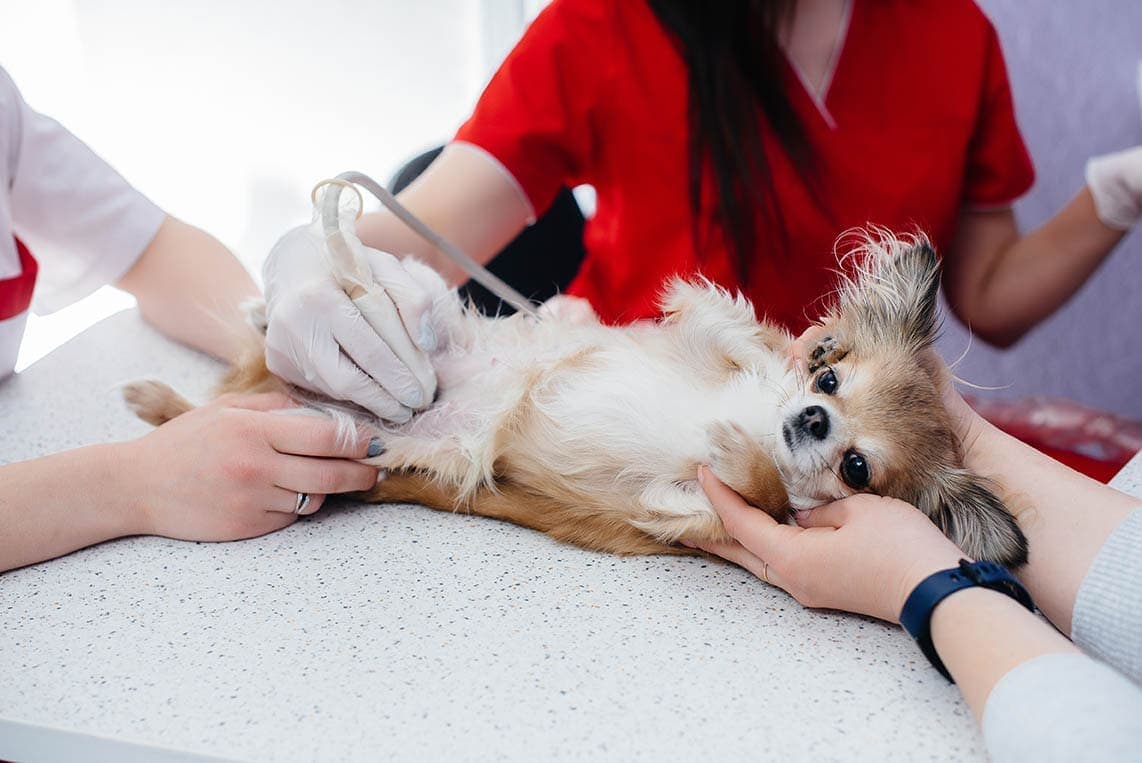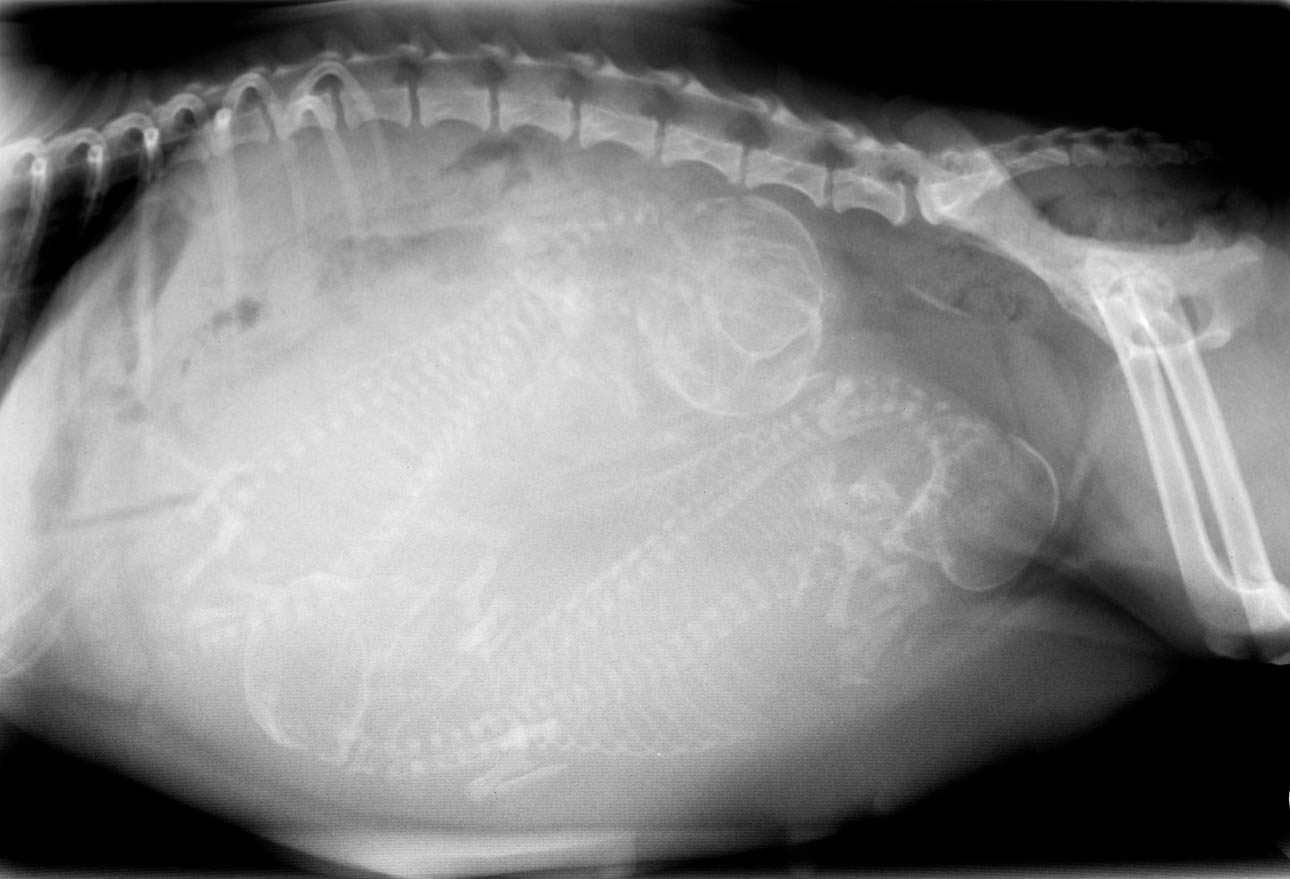Click to Skip Ahead
They say a dog is a man’s best friend. It goes to a whole new level when the same dog welcomes a new litter of puppies. When this happens, it becomes friendship coupled with responsibility. Taking care of a dog’s young ones is not easy; it is cost and time-intensive.
So, if you are considering breeding a dog, you need to equip yourself with as much relevant information as possible to help you raise healthy puppies. You must also learn to identify a pregnant dog and how to care for the pregnant bitch.
How Long Are Dogs Pregnant?
Puppies are fun to have around, especially if you are new to breeding. The good thing is that the gestation period for dogs is shorter than in humans. But let’s uncover exactly how long a dog lasts in pregnancy.

Reproductive Cycles in Dogs
You must first understand a dog’s reproductive cycle. A female dog goes into heat roughly every 6 months and lasts for 14 to 21 days. The heat cycle comprises four main stages that breeders use to decide when to begin breeding the dogs.
- Proestrus
Females attract males for 9 days, but they don’t give in to the male’s advances until stage 2. Proestrus signs are bloody discharge and swelling of the vulva.
- Estrus
This period can last about 9 days with a range of 3 to 18 days. The bitch is now receptive to the male. Veterinarians take blood tests and vaginal smears during proestrus and estrus to ensure the breeding of the dogs at the optimal time. Proestrus signs are a decreased discharge that is light in color, with a soft and enlarged vulva. Flagging behavior is common as well, where the bitch moves the tail sideways or lifts it to expose the vagina and sign their receptivity or acceptance of the mount.
- Diestrus
During this stage, the female is no longer attracting males nor does she allow any more mating. All the signs of a swelling vulva are gone, and the heat is over whether she became pregnant or not.
- Anestrus
Describes the period between heat cycles and it lasts for about 4 months but could last more than 6. During this time, the uterus regenerates from the previous estrous and diestrous or pregnancy.
A clear understanding of the heat cycles is crucial in determining the pregnancy time frame. A breeder should monitor the heat cycles and breeding period to enable the veterinarians to perform a pregnancy test to help calculate the conception dates.

How Can You Tell if a Dog Is Pregnant?
There are no instantaneous pregnancy tests for dogs. A breeder has to visit a veterinarian’s office to know if the dog is pregnant or not. Considering all dog’s pregnancy testing techniques are time-sensitive, you should tell your veterinarian the exact period the dog mated.
Here are the main methods that vets use to determine a dog’s pregnancy.
1. Hormone Tests
A veterinarian can perform a blood test to see if the hormone relaxin is being produced. Relaxin production happens only during pregnancy, making it an accurate test of a dog’s pregnancy. The dog must be 21 to 30 days into the pregnancy for the test to be accurate.
2. Ultrasound
A vet can perform an ultrasound on the dog at any point between 25–35 days of gestation to determine if the dog is pregnant. This form of imaging can help detect fetal heartbeats, allowing you to know how many puppies the dog is carrying. Ultrasounds also help the veterinarian calculate the fetus’ gestational age.
3. Palpation
If you are looking for a cheap and effective way to test for pregnancy, this is it. The veterinarian can conduct a palpation 21 to 30 days into gestation. At this stage, the fetus feels like golf balls. The ‘balls’ are the membranes that develop around the fetus to form fluid-filled sacs. Only a veterinarian should do an abdominal palpation to avoid damaging the pups. The sacs lose their distinct shape after a month, so the timing for the palpitation must be right.
4. X-Ray
X-rays are an effective way to test for pregnancy and determine the number of puppies to expect from the dog. An X-ray will only give the desired results 42 to 45 days into the pregnancy when the fetal spine and skull are visible. It could help you plan for an elective cesarean for the dog.
Gestation Period: How Long Are Dogs Pregnant?
Dogs are pregnant for around 63 days from conception, approximately 2 months. But predicting the exact time of delivery is not always easy because the breeding date sometimes differs from the date of conception. Breed and litter size also determine the gestation period.
If you want a more precise plan for your breeding and gestation time frame, a veterinary officer can conduct hormone measurements and vaginal cytology tests. The process involves using blood tests and vaginal smears to keep track of the reproductive hormones during the breeding process. These kinds of tests can be performed to help you know the appropriate time to breed the bitch, the gestation time frame, and the potential delivery date.
Dogs have a much shorter gestation period than humans, just 9 weeks, and every day counts. Knowing the pregnancy time frame is valuable for the bitch’s health and the puppies for nutrition monitoring and veterinarian care.
- 56 to 58 days from the beginning of diestrus
- 64 to 66 days from the initial rise of progesterone
- 58 to 78 days from the time breeding began
Dogs have a much lower gestation period than humans, just 9 weeks, and every day counts. Knowing the pregnancy time frame is vital for the bitch’s health and the puppies for nutrition monitoring and veterinarian care.

Signs of Pregnancy in Dogs
Diagnostic testing is the most accurate way to tell if a dog is pregnant. But there are some other observable signs of pregnancy in dogs you can note as well. However, some signs of dog pregnancy can also be confused with certain dog illnesses, so if you think your dog is pregnant, bring her to a veterinarian.
Here are the signs of pregnancy in dogs you should look for.
1. Change in Appetite
A pregnant dog’s appetite changes based on the dog and the pregnancy stage. Early into the pregnancy, you will notice less eating and maybe even vomiting. But don’t be surprised if, as the pregnancy progresses, she eats more and seems to never get satisfied. These fluctuations are due to the changing hormones and the nutrition required to support the development of the puppy fetuses.
2. Decreased Activity
If the dog’s activity level decreases and the dog spends more time sleeping, that may be a sign of pregnancy. These signs are easy to notice in a typical energetic dog and hard to detect for dogs that enjoy dozing all day and have low activity levels. For such a dog, keep track of how quickly she gets exhausted when taking walks.
3. Increased Nipple Size
Dog’s nipples are normally small but enlarge significantly during pregnancy’s early stages. The flat areolas become rounded. The nipples also become slightly dark red due to increased blood flow. In later stages of pregnancy, the nipples may even start to leak milk.

4. Unusual Behavior
Behavior change is another sign of a dog’s pregnancy. A pregnant dog tends to spend time at the owner’s side trying to get some attention. However, she also may seem depressed or irritated every time you want to give her attention. This varies depending on the dog.
5. Weight Gain
The abdomen enlarges in size as the puppies grow in the womb. Most times, this is the clearest sign of a dog’s pregnancy. Weight gain usually occurs a little later into the pregnancy.
6. Nesting
As the gestation period nears its end, the dog begins to create a nest. She also becomes easily irritated and secluded. At this stage, it’s better to limit her interaction with the children. Please ensure she is calm and cared for while giving her some space during this time. You can also ensure she has an appropriate space to birth her puppies by providing a whelping box.

Caring for a Pregnant Dog
Once a dog’s pregnancy is confirmed, there are some steps you need to take to ensure the dog stays healthy throughout the pregnancy.
Proper Nutrition
You must see to it that the bitch receives proper nutrition when she is pregnant. Unless directed by the veterinarian, no dietary changes may be needed the first two-thirds of the pregnancy period if she is already feeding on quality dog food. Also, note that excess food can be harmful to the dog.
As she gains weight in the last weeks of gestation, it is recommended that you gradually increase food intake. At some stages of the pregnancy, some dogs require almost double the calories they would normally consume. Your veterinarian will be the best guide, but generally, it is recommended to change their diet to a calorie and nutrient-rich puppy food to support the pregnancy requirements and puppy development. You should feed her with small and frequent meals throughout the day compared to single large quantities to avoid discomfort.
Exercise
Exercise for the pregnant dog should not be strenuous, especially during the first 2 weeks of pregnancy. After 2 weeks, normal exercise may resume until the dog’s belly begins to enlarge.
As birthing nears, the dog must stay away from other dogs and animals. Limit exercise to the indoors only so that she does not contract diseases that may be detrimental to her and the puppy’s health. It will also limit her exposure to canine herpes, a condition that leads to still-born puppies.

Veterinarian Visits
A prenatal checkup is essential before breeding your dog; vaccinations must also be up to date. A fecal exam helps rule out any intestinal parasites.
Regular visits to the veterinarian are advised during the gestation period. You should also inquire from the veterinarian what to do if an emergency arises during the last days of pregnancy. After the veterinarian confirms pregnancy, they should do a mechanical or anatomical examination to determine anything that may hinder a normal whelped litter.
The veterinarian will then advise on the best method of delivery. If the dog got pregnant by accident, this is a good time to discuss the appropriate precautions you should take in the future, such as spaying, to prevent unplanned litters.
Speak to your veterinarian about the possibility of needing to deworm the bitch. If needed, some medications are given daily on the 40th day of pregnancy and continue until 2 days after the birth of the puppies, while others are only offered on days 40 and 55 of pregnancy. Not every medication is safe to give to a pregnant dog, and moreover, it might not be required, so please do not medicate your dog without a veterinarian’s prescription. If your vet recommends deworming her, they will offer you the safest and most effective treatment to protect the puppies from getting worms from the mother after birth, allowing them to grow into healthy dogs.
Potential Dog Labor Complications
- If 64 days after her last mating there are no signs of whelping.
- The dog’s rectal temperature decreased more than a day ago and labor is not beginning.
- Failure to produce a puppy after 20–30 minutes of contractions. Ensure you carry the already born puppies with you if the veterinarian recommends surgery.
- Bitch passes a green vaginal discharge, but still, no puppy is born within 4 hours.
- More than 2 hours pass and the bitch only has weak contractions between pups, yet there are more inside.
- Serious trembling and collapsing are indications of a complication that could put the dog and puppies at risk.
- If you notice excessive blood or an unpleasant very smelly discharge.
- If all the placentas are not delivered, as there should be one per puppy.
- If puppies fail to nurse.
Related Reads:
- Abnormalities of Dog Pregnancy
- Postpartum Eclampsia in Dogs
- Can Dogs Sense Pregnancy? What Science Tells Us!
Conclusion
The pregnancy period can take a toll on you and the dog. That’s why you need to learn about a dog’s pregnancy beforehand so that you are better prepared to care for your soon-to-be mom. The more you learn about this process, the better prepared you will be, and when the pups are born, your work will be well cut out for you. You must be fully ready to raise healthy and well-socialized dogs. It’s a big responsibility, but you will hack it.
Related Dog Reads:
- Microchipping Your Pet: Pros, Cons, & Costs (Is It Worth It?)
- 12 Tips for Building a Dog-Friendly Garden
- Can Cats Eat Sweet Potato? What You Need to Know
Featured Image Credit: WilleeCole Photography, Shutterstock














